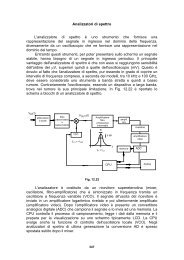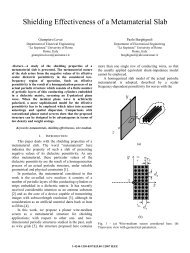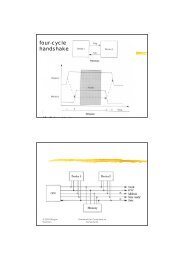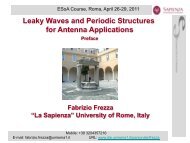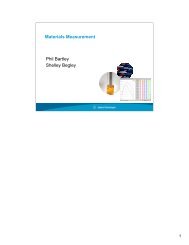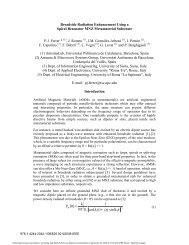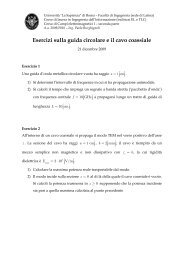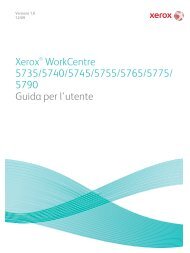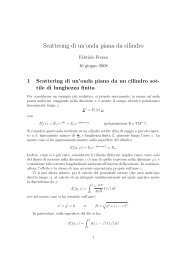Introduction to Traveling-Wave antennas.pdf
Introduction to Traveling-Wave antennas.pdf
Introduction to Traveling-Wave antennas.pdf
Create successful ePaper yourself
Turn your PDF publications into a flip-book with our unique Google optimized e-Paper software.
3 <strong>Introduction</strong> <strong>to</strong> TWAmeasured between half power points (3dB), is:1∆θ ≃L(2)λ ocos θ mwhere L is the length of the leaky-wave antenna, and ∆θ is expressed in radians. For90% of the power radiated it can be assumed:L≃ 0.18αλ o k o⇒ ∆θ ∝ α k oSince leakage occurs over the length of the slit in the waveguiding structure, thewhole length constitutes the antenna’s effective aperture unless the leakage rate is sogreat that the power has effectively leaked away before reaching the end of the slit.A large attenuation constant implies a short effective aperture, so that the radiatedbeam has a large beamwidth. Conversely, a low value of α results in a longeffective aperture and a narrow beam, provided the physical aperture is sufficientlylong.Since power is radiated continuously along the length, the aperture field of a leakywaveantenna with strictly uniform geometry has an exponential decay (usually slow),so that the sidelobe behavior is poor. The presence of the sidelobes is essentially due<strong>to</strong> the fact that the structure is finite along z.When we change the cross-sectional geometry of the guiding structure <strong>to</strong> modifythe value of α at some point z, however, it is likely that the value of β at that pointis also modified slightly. However, since β must not be changed, the geometry mustbe further altered <strong>to</strong> res<strong>to</strong>re the value of β, thereby changing α somewhat as well.In practice, this difficulty may require a two-step process. The practice is then <strong>to</strong>vary the value of α slowly along the length in a specified way while maintaining βconstant (that is the angle of maximum radiation), so as <strong>to</strong> adjust the amplitude ofthe aperture distribution A(z) <strong>to</strong> yield the desired sidelobe performance.We can divide uniform leaky-wave <strong>antennas</strong> in<strong>to</strong> air-filled ones and partiallydielectric-filled ones. In the first case, since the transverse wavenumber k t is then aconstant with frequency, the beamwidth of the radiation remains exactly constantas the beam is scanned by varying the frequency. In fact, since:where:cos 2 θ m = 1 −( βk o) 2(3)k 2 o = k 2 t + β 2 ⇒( βk o) 2= 1 −(ktk o) 2⇒ cos θ m = k t⇒ ∆θ ≃ 2πk o k t L = λ cLEuropean School of Antennas




